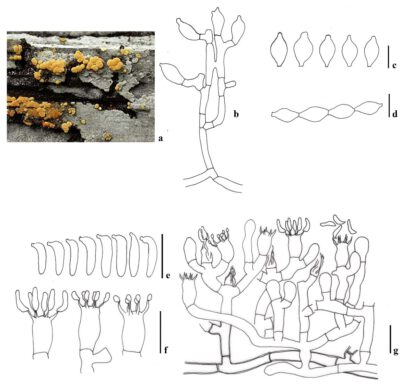Fungalpedia – Note 149 Botryobasidium
Botryobasidium Donk
Citation if using this entry: Bera et al. (in prep) – Fungalpedia, Basidiomycota 1. Mycosphere.
Index Fungorum, MycoBank, Facesoffungi, GenBank, Fig. 1
Botryobasidiaceae, Cantharellales, Agaricomycetes, Basidiomycota, Fungi
Botryobasidium is a saprobic genus having resupinate basidiomata exhibiting various surface textures ranging from smooth, to arachnoid, hypochnoid, pellicular, or grandinioid (Bernicchia et al. 2010). The characteristic short, cylindrical to suburniform, 2–8 sterigmatic basidia are usually arranged in “botryose” clusters and hence the name Botryobasidium (Langer et al. 2000). This kind of arrangement of the basidia makes the hymenial surface granular (Langer et al. 2000). The basidiospores are thick- to thin-walled, limoniform or narrow to broad-navicular or can be globose to ellipsoidal or cylindrical (Langer et al. 2000). The diverse ornamentation of the basidiospores ranges from smooth to verruculose or aculeate, echinulate, laciniate, or tuberculate, and are generally inamyloid (Langer et al. 2000). The hyphae of the members of this genus can be thick- or thin-walled with or without clamp connections but the branching is always at right angles (Langer et al. 2000). The asexual anamorphic forms that produce chlamydospores instead of basidia and basidiospores were previously categorized generally under various generic names. However, a comprehensive review conducted by Holubová-Jechová (1980) concluded that most of these genera should be considered synonymous with Haplotrichum Link as the anamorphic state of Botryobasidium. Haplotrichum aureum (Pers.) Hol.-Jech. is characterized by golden-orange colonies covering small portions of the wood with a pubescent surface which is just a reflection of the protruding conidiophores (Holubová-Jechová 1976, Domański 1988, Piatek & Miskiewicz 2000). The conidiophores are smooth, hyaline, erect, branched with chains of limoniform conidia (Holubová-Jechová 1976, Domański 1988, Piatek & Miskiewicz 2000). Over the years, the anamorphic state of the genus has been more recorded than the teleomorphic state (Eriksson & Ryvarden 1973, Boidin & Gills 1990, Langer 1944). However, in accordance with changes to the International Code of Nomenclature for algae, fungi, and plants, the practice of assigning different names to teleomorph and anamorph forms of the same fungus has been discontinued (Stalpers et al. 2021) and consequently, Haplotrichum and other anamorph genera are now considered synonyms of Botryobasidium. Based on the molecular data, the members of the genus Botryobasidium is revealed to be monophyletic and forms a natural group within the order Cantharellales and sister to other genera like Sistotrema Fr., Cantharellus Adans. ex Fr., Craterellus Pers., Hydnum L., and Clavulina J. Schröt. (Moncalvo et al. 2006). Currently approximately 51 species are recognized under Botryobasidium (CBS 2009, Langer 1994, Parmasto et al. 2004, Bernicchia et al. 2010).
Synonyms: Acladium Link, Allescheriella Henn., Alysidium Kunze, Botryohypochnus Donk, Cyanohypha Jülich, Haplotrichum Link, Phaeoblastophora Partr. & Morgan-Jones, Physospora Fr., Sporocephalium Chevall.
Type species: Botryobasidium subcoronatum (Höhn. & Litsch.) Donk
Other accepted species: Refer Species Fungorum (https://www.speciesfungorum.org/)
Figure 1. a–d Anamorph structures of Botryobasidium aureum, e–g Botryobasidium musaisporum (CCJ 01424-holotype) a. Anamorph of Botryobasidium aureum. b. Anastomosing conidiophores. c. Conidia. d. Chain with four conidia. e. Basidiospores. f. Basidia. g. Basidia at different ontogenetic stages showing old basidia being collapsed, thin-walled subhymenial hyphae and thick-walled basal hyphae. Scale bars: b–d= 20 μm, e, f = 10 μm, g = 20 μm. Picture credit of a: https://www.123pilzsuche-2.de/daten/details/GoldgelbeTraubenbasidie.htm, Drawn from b–d = Piatek & Miskiewicz 2000, e–g = Langer et al. 2000.
References
Bernicchia A, Langer G, Gorjón SP 2010 – Botryobasidium sassofratinoense sp. nov. (Cantharellales, Basidiomycota) from Italy. Mycotaxon, 111(1), 403–409.
Boidin J, Gilles G 1988 – Basidiomycètes aphyllophorales de l’île de la Réunion. X. Compléments aux genres traités antérieurement (1). Bulletin trimestriel de la Société mycologique de France, 104(2), 59–71.
Domański S 1988 – Minor mycoflora. Vol. I. Basidiomycetes Aphyllophorales. Part 5. Corticiaceae. Acanthobasidium-Irpicodon. Minor mycoflora.
Eriksson J, Ryvarden L 1973 – The Corticiaceae of North Europe Volume 2, Aleurodiscus–Confertobasidium. 261 pp.
Holubová-Jechová V 1976 – Haplotrichum Link instead of Oidium Link, a necessary nomenclatural change. Ceska Mykol, 30(1), 3–4.
Holubová-Jechová V 1980 – Revision and subdivision of Haplotrichum-anamorphs of Botryobasidium. Mycotaxon, 12, 122–130.
Langer G 1994 – Die Gattung Botryobasidium Donk (Corticiaceae, Basidiomycetes). Bibliotheca Mycologica, Band 158. J. Cramer. Berlin. Stuttgart.
Langer G, Langer E, Chee-Jen CHEN 2000 – Botryobasidium musaisporum sp. nov. collected in Taiwan. Mycological Research, 104(4), 510–512.
Moncalvo JM, Nilsson RH, Koster B, Dunham SM, Bernauer T, Matheny PB, …Vilgalys R 2006 – The cantharelloid clade: dealing with incongruent gene trees and phylogenetic reconstruction methods. Mycologia, 98(6), 937–948.
Parmasto E, Nilsson RH, Larsson KH 2004 – Cortbase version 2–extensive updates of a nomenclatural database for corticioid fungi (Hymenomycetes). Phyloinformatics, 5, 1–7.
Piatek M, Miskiewicz A 2000 – Botryobasidium aureum [Fungi, Stereales] in the Tatra Mts and review of its distribution in Poland. Fragmenta Floristica et Geobotanica, 45(1–2).
Stalpers JA, Redhead SA, May TW, Rossman AY, Crouch JA, Cubeta MA, …Thorn RG 2021 – Competing sexual-asexual generic names in Agaricomycotina (Basidiomycota) with recommendations for use. IMA fungus, 12(1), 1–31.
Entry by
Ishika Bera, Center of Excellence in Fungal Research, Mae Fah Luang University, Chiang Rai 57100, Thailand
(Edited by Kevin D Hyde)
Published online 5 October 2023
